Characteristics 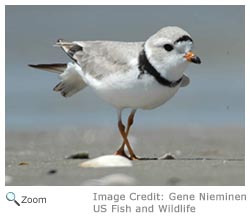 The piping plover is a small, sparrow-sized shorebird. It is about five to seven inches in length. It is a sandy brown-gray on its back and white on its underside. It has a black or brown neck band; a black tip on its tail; white "eyebrows;" a black band across its forehead; yellow-orange legs and feet; and a small, stubby orange bill with a black tip. The piping plover is a small, sparrow-sized shorebird. It is about five to seven inches in length. It is a sandy brown-gray on its back and white on its underside. It has a black or brown neck band; a black tip on its tail; white "eyebrows;" a black band across its forehead; yellow-orange legs and feet; and a small, stubby orange bill with a black tip.
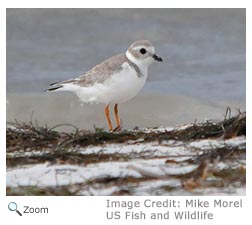 In winter, the piping plover's black bands fade or disappear and its legs fade to a paler yellow-orange and its bill becomes black.
Males and females are similar in appearance, but the male is a little larger and the base of its bill is a brighter orange during breeding season.
The piping plover gets its name from the piping sound of its call. In winter, the piping plover's black bands fade or disappear and its legs fade to a paler yellow-orange and its bill becomes black.
Males and females are similar in appearance, but the male is a little larger and the base of its bill is a brighter orange during breeding season.
The piping plover gets its name from the piping sound of its call.
Range
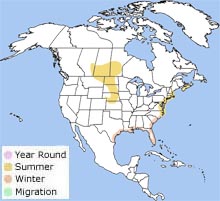 The piping plover breeds
on the northern Great Plains from Alberta, Canada south to Oklahoma, along the northern Great Lakes and along the Atlantic coast from Newfoundland to North Carolina.
It winters
on the Gulf coast and the southern Atlantic coast north to North Carolina. The piping plover is an endangered species in New Hampshire. The piping plover breeds
on the northern Great Plains from Alberta, Canada south to Oklahoma, along the northern Great Lakes and along the Atlantic coast from Newfoundland to North Carolina.
It winters
on the Gulf coast and the southern Atlantic coast north to North Carolina. The piping plover is an endangered species in New Hampshire.
Habitat
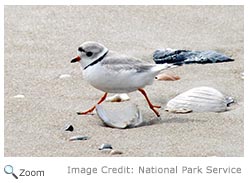 The piping plover can be found on sandy beaches on the coast and in dry, sandy areas inland. The piping plover can be found on sandy beaches on the coast and in dry, sandy areas inland.
|
|
Diet
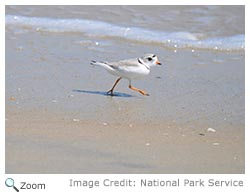 Piping plovers eat marine worms, fly larvae, beetles, insects, crustaceans, mollusks and other small invertebrates. When its spots its prey, it quickly runs after it, stops suddenly, and then quickly snatches it up. Piping plovers eat marine worms, fly larvae, beetles, insects, crustaceans, mollusks and other small invertebrates. When its spots its prey, it quickly runs after it, stops suddenly, and then quickly snatches it up.
Life Cycle
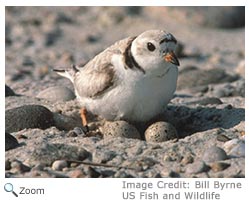 The piping plover returns to its breeding ground in late March or early April. The male piping plover courts the female by flying over her and swooping down close to the ground. The male selects the nest site and defends it from other plovers.
He then starts scraping a nest in the sand above the high tide line. Both the male and female may toss
stones and shell fragments into the depression. The female piping
plover usually lays four eggs. The piping plover returns to its breeding ground in late March or early April. The male piping plover courts the female by flying over her and swooping down close to the ground. The male selects the nest site and defends it from other plovers.
He then starts scraping a nest in the sand above the high tide line. Both the male and female may toss
stones and shell fragments into the depression. The female piping
plover usually lays four eggs.
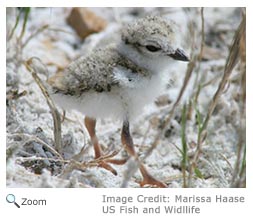 The eggs hatch in about 25 days and the
chicks fledge when they are three to four weeks old. The parents don't
feed the chicks. The chicks hop out of the nest and forage for food themselves. If the young a threatened by a predator, the adult may pretend to have a broken wing to lure the predator away! The eggs hatch in about 25 days and the
chicks fledge when they are three to four weeks old. The parents don't
feed the chicks. The chicks hop out of the nest and forage for food themselves. If the young a threatened by a predator, the adult may pretend to have a broken wing to lure the predator away!
Behavior
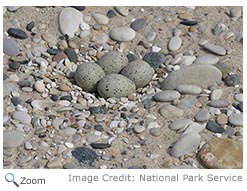 Piping plovers and their eggs blend in very well with the sand, which is good camouflage from predators, but it can put them in danger of being stepped on by humans. In some areas, the piping plover is endangered. Piping plovers and their eggs blend in very well with the sand, which is good camouflage from predators, but it can put them in danger of being stepped on by humans. In some areas, the piping plover is endangered.
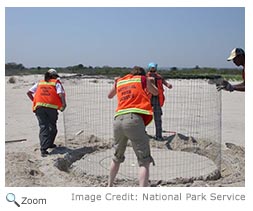 The spread of human developments in ocean side and lakeshore areas has disturbed or destroyed the nesting site of the piping plover. On some beaches, the nesting areas of piping plovers are closed off so people don't step on the eggs. The spread of human developments in ocean side and lakeshore areas has disturbed or destroyed the nesting site of the piping plover. On some beaches, the nesting areas of piping plovers are closed off so people don't step on the eggs.
|